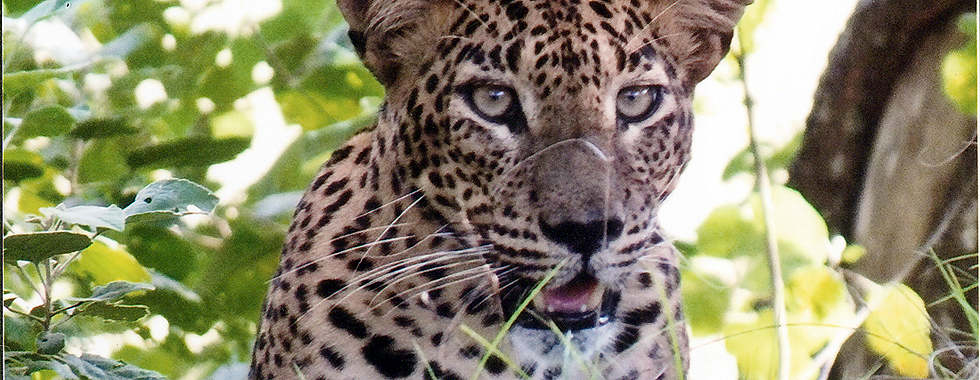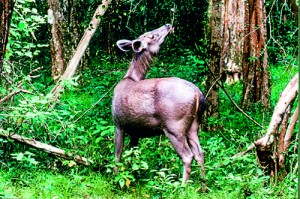Spotting the Lord of the jungle
The city lights ebbed away one by one as we hit the Puttalam-Anuradhapura road. It was nearly 11 p.m. as thoughts of Thimbiriweva junction entered our subconscious.
We had been fortunate to watch Rangana Herath spin Sri Lanka to a famous win over New Zealand at dinner; but now, a thrill only those familiar with the wilds experience, engulfed us. We were bound for Wilpattu National Park, which in the 1960s’ and ‘70s’, was renowned as being the best place in the world to see and photograph the leopard.
Wilpattu has survived the ravages of the 25-year war which had, however left an almost indelible mark on its inhabitants. A couple of years ago, one could traverse the length and breadth of the park without seeing as much as a wild boar. Now, the population of leopard and bear, the density of which remains unknown due to the lack of reliable documentation, appears to have stabilised, if not increased.
The break of dawn over Wilpattu is an experience which borders on the mystical. The “chuck-chuck-chuckooo” of the nightjar gives way to the strident “Jock, George, Joyce” of the jungle fowl and the startled “did-you-do-it” of the red-wattled lapwing. The nervous belling of the sambhur is replaced by the hoarse “kharr, kharr” of the barking deer and the “khracow” of the ever alert langur sentinel. The shadowy forms lying on the dew laden grass become discernible as those of spotted deer, who have been fortunate enough to see the light of another day.
 The sun was climbing higher and we had just left the white sands of Kudapatassa en route to Panikkar Villu bungalow, when on the road leading up to Kuruttupandi Villu, the tracker suddenly stopped the four wheel drive. There, imprinted on the soft sand moistened by the early morning dew, were the pug marks of the spotted one; a glimpse of whom everyone was longing for. They continued along the jungle track and it appeared to have given us the slip. The keen ears of Ajith the driver, however, picked up the alarm calls of a langur. The pug marks left the track and headed for the deeper cover of the jungle. The tone of the langur watchman suggested that he had either seen or was indeed looking at the leopard right then.
The sun was climbing higher and we had just left the white sands of Kudapatassa en route to Panikkar Villu bungalow, when on the road leading up to Kuruttupandi Villu, the tracker suddenly stopped the four wheel drive. There, imprinted on the soft sand moistened by the early morning dew, were the pug marks of the spotted one; a glimpse of whom everyone was longing for. They continued along the jungle track and it appeared to have given us the slip. The keen ears of Ajith the driver, however, picked up the alarm calls of a langur. The pug marks left the track and headed for the deeper cover of the jungle. The tone of the langur watchman suggested that he had either seen or was indeed looking at the leopard right then.
We all held our breath, tensed our muscles and peered into the scrub to no avail. We waited all of 20 minutes but it didn’t show up. The tracker decided that we should drive up to Kuruttupandi Villu and return the same way. We did as we were asked. Returning, a little before where the langur had sounded his alarm call, on the main road, ambling away from us was a magnificent leopard.
Our nerves jangled with excitement for this indeed was the Lord of the Sri Lankan jungles we had come all this way to see. He scarcely looked back, but disdainfully continued his journey up the track. He then decided to lie down, all the time facing away from us. Perhaps his mind was on the quarry he had spotted a while ago; perhaps he was thinking of a way of disappearing from the intruders who had rudely disturbed his morning’s programme. He continued to wait thus, occasionally looking back over his shoulder as if to say “haven’t you had your fill yet?” Then he proceeded to sit up and give himself a good scratch with his sinewy back leg. He continued the ablutions, meticulously licking his flank and hind quarters. Once satisfied, he stood up, walked over to the scrub bordering the track, and was gone in an instant. Only his pug marks remained as telltale evidence of his presence. We thereafter drove into the bungalow without any further sightings.
Panikkar Villu lies in the very heart of Wilpattu, in absolute leopard terrain, ensconced between Tala Wila and Nelum Wila. It is one of the five existing bungalows not taking into account the yet non-commissioned Manikkapola Uttu, Lunuwewa and Mahawewa bungalows. Panikkar Villu bungalow which is as spacious as any of the modern wild life lodges go, with half walls ensuring clear visibility over the villu, is well known for several interesting leopard tales. One being an encounter between a male leopard and a particularly large sounder of wild boar, which defence he had attempted to breach. The boars had “treed” the leopard on a gnarled tree in front of the bungalow. The bungalow keeper who had been woken by a series of agitated snorts and grunts was witness to this skirmish which left the leopard the loser; for having lost patience, he leapt off the tree hoping to get away and landed in the middle of the sounder. He was mercilessly gored and ripped by the pigs, within an inch of his life.
After a refreshing wash, we proceeded to sit down to a pre-lunch “pick-me-up”. We sat, drinking in the ambience that only the dry zone forests of Sri Lanka offer. The cool breeze over the villu; the rustle of the leaves; the silvery ripples of the water; the bright sunlight; wide open spaces as far as the eye can see; the soporific cooing of the spotted dove – these indeed are a soothing balm for the shattered nerves of any poor city worn soul. Conversation and laughter filled the air as we made plans for the evening’s safari. Tony’s excited cry of “leopard, leopard”, sent us helter skelter, rushing for cameras and binoculars and the like.
It was now 2 p.m. and surely no self-respecting leopard was going to brave the noon day heat and come out into the open. But to everyone’s consternation, at the far end of the villu was a leopard, striding purposefully towards a dead log. On the further edge of the villu was a sounder of wild boar which included several succulent piglets in its ranks. The leopard hurried towards the log which was close to the pigs. There he took refuge behind a branch and kept on looking at the possible meal. We were elated at the opportunity of viewing a leopard virtually from our armchairs. After a while, he decided that the young piglets were too well protected and proceeded to slink away into the far jungle.
A myriad different sounds and calls fill one’s ears as night descends over Wilpattu. To a trained ear each of these sounds represent a drama being enacted under the veil of darkness – from the incessant “crick, crick, crick,” chorus of contented frogs which stops abruptly, giving way to an eerie silence when a predator approaches, to the agitated alarm call of the spotted deer, as they signal one another indicating the presence of the dreaded foe. Dusk is also the best time to observe the brown fish owl as it sits statue-like on a wayside culvert or dead stump; its piercing eyes with their hypnotic yellow irides fixing you with an unflinching stare.
This night was no different; being relatively peaceful. However a sambhur doe who was feeding in front of the bungalow, appeared quite restless throughout the night, assailing our ears several times, with her brassy belling. As dawn broke, we could see her feeding undisturbed. We were however puzzled no end by her behaviour in the night, as we set out on our morning round.
Hardly had the jeep left the Panikkar Villa plain and entered the jungle track leading to Nelum wila, than it was brought to a screeching halt by a stentorian “hoew, hoew,” by Upul the tracker.
There to the right of us sleeping the sleep of the replete, stomach heaving up and down was “Mr. Spots” himself. It was now clear why the sambhur doe had been behaving fitfully. The leopard appeared to have gorged himself on some unfortunate animal. His spotted white belly was well camouflaged as it merged with the white sand of the dunes on which he slept. We watched him for over an hour as he rolled over lazily, yawning several times. Every now and then he would look at us, his baleful amber green eyes seemingly searching the very depths of our souls.
Tell me, is there a better place to observe this majestic feline in all his imperious glory? No, I don’t think so!


